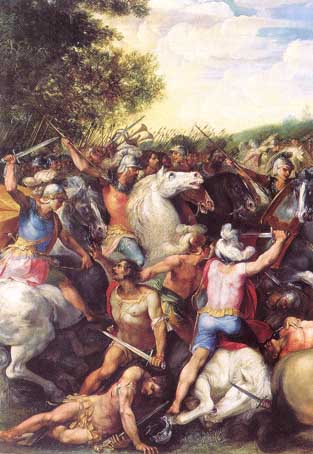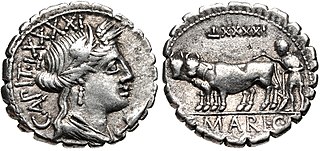Related Research Articles
The gens Gabinia was a plebeian family at ancient Rome. Members of this gens first appear in the second century BC. The nomen derives from the city of Gabii, east of Rome.

The gens Lutatia, occasionally written Luctatia, was a plebeian family of ancient Rome. The first of the gens to obtain the consulship was Gaius Lutatius Catulus in 242 BC, the final year of the First Punic War. Orosius mentions their burial place, the sepulchrum Lutatiorum, which lay beyond the Tiber.
The gens Curiatia was a distinguished family at Rome, with both patrician and plebeian branches. Members of this gens are mentioned in connection with the reign of Tullus Hostilius, the third King of Rome, during the seventh century BC. The first of the Curiatii to attain any significant office was Publius Curiatius Fistus, surnamed Trigeminus, who held the consulship in 453 BC. The gens continued to exist throughout the Republic, and perhaps into imperial times, but seldom did its members achieve any prominence.
Spurius Carvilius Maximus Ruga was Roman consul in 234 and 228 BC. Spurius Carvilius Ruga, the schoolteacher, was his freedman.
The gens Blossia, also spelled Blosia, was a Roman family of Campanian origin, which came to prominence during the Second Punic War. The most famous member of this gens is probably Gaius Blossius, an intimate friend of Tiberius Sempronius Gracchus, whom he urged to bring forward his agrarian law. He fled from Rome after the murder of Gracchus, and eventually took his own life for fear of falling into the hands of his enemies.
The gens Caesetia was a minor plebeian family at ancient Rome. It is known from a small number of individuals living during the late Republic.

The gens Hostilia was an ancient family at Rome, which traced its origin to the time of Romulus. The most famous member of the gens was Tullus Hostilius, the third King of Rome; however, all of the Hostilii known from the time of the Republic were plebeians. Several of the Hostilii were distinguished during the Punic Wars. The first of the family to obtain the consulship was Aulus Hostilius Mancinus in 170 BC.

The gens Maria was a plebeian family of Rome. Its most celebrated member was Gaius Marius, one of the greatest generals of antiquity, and seven times consul.
The gens Verginia or Virginia was a prominent family at ancient Rome, which from an early period was divided into patrician and plebeian branches. The gens was of great antiquity. It frequently filled the highest honors of the state during the early years of the Republic. The first of the family who obtained the consulship was Opiter Verginius Tricostus in 502 BC, the seventh year of the Republic. The plebeian members of the family were also numbered amongst the early tribunes of the people.

The gens Curtia was an ancient but minor noble family at Rome, with both patrician and plebeian branches. The only member of the gens invested with the consulship under the Republic was Gaius Curtius Philo, in 445 BC. A few Curtii held lesser magistracies during the Republic, and there were two consuls suffectus in imperial times. However, the gens is best remembered from a series of legends dating from the traditional founding of the city to the early Republic.
The gens Duronia was a plebeian family at ancient Rome. Although relatively obscure, the family was of sufficient importance to hold a seat in the Roman Senate. Its members are mentioned during the first and second centuries BC.
The gens Egnatia was a plebeian family of equestrian rank at ancient Rome. Only a few of the Egnatii held any magistracies, of whom the most important may have been Gnaeus Egnatius, who held the praetorship during the second century BC, and served as governor of Macedonia, shortly after its institution as a Roman province.
The gens Laetoria was a plebeian family at ancient Rome. Its members appear regularly throughout the history of the Republic. None of the Laetorii ever obtained the consulship, but several achieved lesser offices of the Roman state.

The gens Fonteia was a plebeian family at ancient Rome. Members of this gens are first mentioned toward the end of the third century BC; Titus Fonteius was a legate of Publius Cornelius Scipio during the Second Punic War. The first of the Fonteii to obtain the consulship was Gaius Fonteius Capito, consul suffectus in 33 BC.
The gens Geminia was a plebeian family at Rome. The only member of this gens to hold any of the higher offices of the Roman state under the Republic was Gaius Geminius, praetor in 92 BC.
The gens Grania was a plebeian family at ancient Rome. Although none of them ever obtained the consulship, the family was of "senatorial rank", and was well known from the latter half of the second century BC. In Imperial times, a number of them became distinguished in military and provincial service.
The gens Hortensia was an ancient plebeian family in Rome. Members of this gens are first mentioned in the fifth century BC, but from that time somewhat infrequently until the final century of the Republic. The most illustrious of the gens was the orator Quintus Hortensius, a man of great learning, and a contemporary of Cicero. Under the Empire they seem to have sunk back into obscurity.
The gens Villia was a plebeian family at Rome. Its members are mentioned in the first century of the Republic, but the only Villius who obtained the consulship was Publius Villius Tappulus, in BC 199.
The gens Laelia was a plebeian family at Rome. The first of the gens to obtain the consulship was Gaius Laelius in 190 BC.
The gens Titinia was a minor plebeian family at ancient Rome. Members of this gens are mentioned as early as the time of the decemvirs, but only a few held any magistracies, and none of them ever attained the consulship.
References
- ↑ Dictionary of Greek and Roman Biography and Mythology , William Smith, Editor.
- ↑ Titus Livius, Ab Urbe Condita , vi. 30.
- ↑ Dictionary of Greek and Roman Biography and Mythology , William Smith, Editor.
- ↑ George Davis Chase, "The Origin of Roman Praenomina", in Harvard Studies in Classical Philology, vol. VIII (1897).
- ↑ Dictionary of Greek and Roman Biography and Mythology , William Smith, Editor.
- ↑ Dictionary of Greek and Roman Biography and Mythology , William Smith, Editor.
- ↑ Titus Livius, Ab Urbe Condita , vi. 30.
- ↑ Titus Livius, Ab Urbe Condita Epitome, 14.
- ↑ Valerius Maximus, Factorum ac Dictorum Memorabilium libri IX, viii. 1. damn. 5.
- ↑ Titus Livius, Ab Urbe Condita , xxvii. 9, 10.
- ↑ Plutarchus, Lives of the Noble Greeks and Romans , "Marius", 40.
- ↑ Appianus, Bellum Civile, i. 62.
- ↑ Valerius Maximus, Factorum ac Dictorum Memorabilium libri IX, v. 3. § 3.
- ↑ Marcus Tullius Cicero, De Oratore , iii. 3.
- ↑ Appianus, Bella Mithridatica, 84.
- ↑ Plutarchus, Lives of the Noble Greeks and Romans , "Pompeius," 24.
- ↑ Marcus Tullius Cicero, Pro Lege Manilia, 12.
- ↑ Marcus Tullius Cicero, Pro Flacco, 15.
- ↑ Marcus Tullius Cicero, Pro Flacco, 36.
- ↑ Marcus Terentius Varro, Rerum Rusticarum libri III, i. 1. § 10.
- ↑ Marcus Tullius Cicero, Pro Flacco, 13.
- ↑ Marcus Tullius Cicero, Epistulae ad Quintum Fratrem, ii. 1. § 3.
- ↑ Marcus Tullius Cicero, Pro Flacco, 34.
- ↑ Marcus Tullius Cicero, De Finibus Bonorum et Malorum, ii. 17.
- ↑ Marcus Tullius Cicero, Epistulae ad Familiares, xii. 13. § 4, xiii. 48.
- ↑ Lucius Annaeus Seneca, Suasoriae, 6, pp. 45, 46, ed. Bip.
- ↑ Publius Cornelius Tacitus, Historiae ii. 64, 89, iii. 67.
- ↑ Gaius Suetonius Tranquillus, De Vita Caesarum , "Vitellius," 3.
- ↑ Publius Cornelius Tacitus, Historiae iii. 5, iv. 70.
- ↑ CIL VI, 510, CIL VI, 31118
- ↑ PLRE, vol. 1, pp. 15–16.
Works cited
![]() This article incorporates text from a publication now in the public domain : Smith, William, ed. (1870). Dictionary of Greek and Roman Biography and Mythology .
This article incorporates text from a publication now in the public domain : Smith, William, ed. (1870). Dictionary of Greek and Roman Biography and Mythology .{{cite encyclopedia}}: Missing or empty |title= (help)
- Jones, A.H.M.; J.R. Martindale & J. Morris (1971–1992). Prosopography of the Later Roman Empire. Cambridge University Press. ISBN 0-521-07233-6.